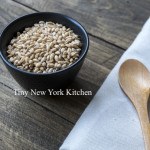Start small, with goals that work for you and your family. These are the habits you’ll keep in the long run.
1. Add More Color To Your Plate
More color on your plate means more variety, more nutrients, and more flavor. The next time you shop, try putting the rainbow in your cart: orange citrus, yellow pineapple, and dark leafy greens.
2. Eat Seasonally
Keep a produce calendar handy so you know what to look for. In season produce is fresher and typically less expensive. January is good for root vegetables, kale, and citrus.
3. Drink More Water
Stay hydrated by infusing your water with citrus slices, herbs, berries, or cucumber. Making water more interesting will encourage you to drink more.
4. Try A Whole Grain Swap For Pasta And Bread
Once in a while replace regular pasta and bread with a whole grain alternative. These complex carbs will help you feel full. Look for whole wheat, whole grain, and multigrain alternatives.
5. Pack Your Snacks
Opt for high fiber and protein snacks like hummus and pretzels or apples and peanut butter. Unlike sugar and empty carbs, fiber ad protein will keep you full.
6. Eat Breakfast More Often
Stock up on on-the-go options. Egg muffins in the freezer, instant oatmeal in the pantry, and a bowl of fruit on the counter. The morning rush won’t be an excuse for skipping this important meal.
7. Make A Shopping List
Check your refrigerator, freezer, and pantry before making a list. Organize your list based on the layout of your store. You’ll save time at the store and won’t accidently buy what you already have.
8. Try A Plant-Based Swap For Meat
Try a meatless version of a weeknight staple like burgers, pizza, or pasta. You’ll get more nutrients into your meals by swapping meat for plant-based options.
9. Stock Your Freezer
Keep staples like frozen meatballs or chicken tenders and steam-in-bag vegetables for last minute meals. A fully stocked freezer is better than takeout. You’ll save money and get dinner on the table even on busy weeknights.
10. Reduce Your Food Waste
Use overripe fruit in smoothies and muffins. Turn leftover vegetables into stir fries and soups. Turning leftover produce into nutrient-dense meals is a win-win for your wallet and your health.
11. Make A Meal Plan
Write meals on the calendar at the start of the week. Everyone knows the menu and you won’t be scrambling for dinner ideas at 5pm.
12. Bring Your Lunch 3 Days Per Week
Instead of swearing off midday takeout, start with 3 days a week. When you pack school lunches, pack office lunches too. You’ll save time waiting in line, save money, and eat better.
13. Try A New Recipe
Shake up your dinner routine with a recipe or ingredient you haven’t use before. You’ll avoid a recipe rut and learn new kitchen skills.
14. Eat Out One Less Time Each Week
Try a speedy dinner or slow cooker meal that’s ready when you get home. Home cooked meals allow you to control the ingredients and choose more healthful options.
15. Drink Less Soda
Swap for flavored seltzer, iced tea, or sparkling fruit juice. Instead of cutting out soda try drinking 1 less can a day. Quitting cold turkey makes habits hard to break. Start with a smaller goal and eventually it will make a big difference.
16. Eat Together One More Night Each Week
Make dinner device-free, with everyone eating together. Keep it fun with a top-your-own taco, baked potato, or burger night. Enjoying a meal together as a family has been shown to encourage healthy eating habits and better communication.
17. Cook With Your Children Once A Week
Children who help choose, shop for, and prepare a recipe will be more interested in eating it.
18. Get Ahead On Sunday
Prep components instead of entire meals. Roast vegetables, cook grains, and bake extra chicken, then mix and match for quick lunches and dinners during the week. Planning ahead helps you save time, eat better, and reduce the stress of busy weeks.
19. Embrace Healthy Fats
Look for sources of unsaturated fats, like olive oil, nuts, seeds, and avocados. Good-for-you fats help regulate cholesterol, absorb vitamins, and prevent heart disease.
20. Give Plants More Plate Real Estate
Fill about half of your dinner plate with plants, then divide the rest between your starch and protein. Rebalancing your plate is an easy way to eat healthfully.
“Work With What You Got!”
©Tiny New York Kitchen © 2019 All Rights Reserved
If you want to lower your risk of heart disease and lose weight, without feeling deprived, the Mediterranean diet just might be the plan for you. The Mediterranean diet is known for being one of the healthiest eating patterns and one of the easiest plans to follow. In fact, research has shown that it can lower bad cholesterol, lower risk for certain types of cancer, and even improve brain health. The Mediterranean diet doesn’t call for eliminating entire food groups, but encourages smart choices from each.
GRAINS
Many of the grains you will find available in the Mediterranean diet, like barley and buckwheat, are whole grains, which have so many health benefits. Whole grains are not only packed with heart-healthy vitamins and antioxidants, they also contain fiber. Fiber is good for digestive health and heart health, as it can help lower LDL cholesterol (the type of cholesterol that causes heart disease). The Mediterranean diet also encourages enjoying whole-grain breads with olive oil instead of butter because of the heart-health benefits.
FRUITS & VEGETABLES
The diet places an emphasis on consuming plenty of fruits and vegetables. Cucumbers, tomatoes, kale, onions, bell peppers, broccoli, and spinach are all great examples. Combining vegetables with whole grains, in a pasta salad or couscous for example, is a great way to enjoy both. Fruits such as berries, apples, melons, and figs all make great snack or even dessert options. For breakfast you can easily combine fruits with whole grains for a breakfast muesli or try blueberry pancakes made with buckwheat.
PROTEIN
Protein from lean sources such as poultry and seafood are encouraged at least twice a week. However, red meat is supposed to be limited to only a few times per month. Seafood is encouraged because of the heart healthy fats, which are good for brain and heart health. Lean poultry is encouraged because it’s low in saturated fat, but high in protein, which is good for muscle building and satiety. Lemon chicken salad or Tuscan chicken stew would both be great dishes to include on the plan.
DAIRY
Dairy is allowed on the Mediterranean diet, but moderation is key. Instead of fat-free or sugar-free yogurt, switch to plain Greek yogurt, which is lower in sugar, but higher in protein. Low-fat milk and cheeses like feta and brie are also allowed, but moderation is encouraged because of their saturated fat and sodium content. For a simple and healthy weeknight dinner, try combining grilled chicken kabobs with a lemon-dill Greek yogurt dipping sauce.
NUTS & LEGUMES
Nuts, seeds, and legumes are encouraged because they contain heart-healthy fats and fiber. Almonds, walnuts, cashews, peanuts, and sesame seeds can be enjoyed as a snack or sprinkled on vegetables or hot cereals. Legumes, such as split peas and red lentils, are great in soups, stews or on top of salads. Try making hummus at home by using chickpeas, olive oil, and lemon juice, then enjoy it with grilled chicken, sliced bell peppers, and whole-wheat pita bread.
HEART-HEALTHY FATS
Saturated fats like butter are discouraged on the Mediterranean diet, which instead urges heart-healthy fats from olive oil, nuts, seeds, and avocados. Heart-healthy fats can actually help raise HDL cholesterol, which is the good cholesterol that our bodies make in order to fight heart disease. To incorporate them, opt for a baked potato with a drizzle of olive oil, or try adding diced avocado to green salads with grilled chicken. If creamy chicken salad is more your pace, serve it with chopped olives.
SEASONINGS
Instead of using salt to season your dishes, the use of herbs and spices is highly encouraged on the Mediterranean diet. Garlic, rosemary, thyme, sage, mint, and basil are all great flavors to add to simply grilled chicken or green salads. Citrus juice from lemons, limes, and oranges can also add flavor that’s perfect for salads and marinades. Try experimenting at home with different seasonings, and find what works for you.
VARIETY & BALANCE
The Mediterranean diet has a lot to offer in terms of variety and health benefits. In additions to focusing on making smart choices, the plan also encourages family meals and making time for physical activity. Lean protein, whole grains, fruits, vegetables, and low-fat dairy are all smart choices that can help you maintain a Mediterranean-style eating pattern. One you and your family can stick to.
“Work With What You Got!”
©Tiny New York Kitchen © 2019 All Rights Reserved











